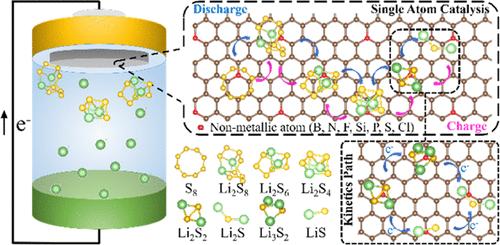当前位置:
X-MOL 学术
›
J. Phys. Chem. C
›
论文详情
Our official English website, www.x-mol.net, welcomes your feedback! (Note: you will need to create a separate account there.)
Theoretical Investigation of Nonmetallic Single-Atom Catalysts for Polysulfide Immobilization and Kinetic Enhancement in Lithium–Sulfur Batteries
The Journal of Physical Chemistry C ( IF 3.7 ) Pub Date : 2024-04-10 , DOI: 10.1021/acs.jpcc.4c00063 Mingwei Wu 1 , Zheng Wei 1 , Kaichuang Fei 1 , Wenshan Xiao 1 , Ju Wu 1 , Xu Xu 1 , Yan Zhao 1, 2, 3 , Qiu He 1, 2
The Journal of Physical Chemistry C ( IF 3.7 ) Pub Date : 2024-04-10 , DOI: 10.1021/acs.jpcc.4c00063 Mingwei Wu 1 , Zheng Wei 1 , Kaichuang Fei 1 , Wenshan Xiao 1 , Ju Wu 1 , Xu Xu 1 , Yan Zhao 1, 2, 3 , Qiu He 1, 2
Affiliation

|
With the increasing interest in tackling the “shuttle effect” of lithium–sulfur (Li–S) batteries, there is a growing emphasis on investigating effective catalysts to improve redox kinetics and understand the associated reaction pathways. In this study, a series of nonmetal (B, N, Si, P, S, F, and Cl) single-atom-doped graphenes were theoretically investigated as the catalysts for the multistep reduction of S8 and the kinetic conversion of the rate-limiting step. Analysis of the Gibbs free energy for the S8 reduction process on these catalysts confirms that the rate-limiting step is the conversion of Li2S2 to Li2S. Subsequently, six kinetic reaction paths transforming Li2S2 to Li2S were constructed. Based on the optimal reaction path with LiS as the intermediate product, a volcano plot was built with the excellent descriptor, −ΔGad(LiS). The peak catalytic efficiency corresponds to a −ΔGad(LiS) value of 1.72 eV. Consequently, pyrrolic N- and Cl-doped graphene are identified as superior catalysts with energy barriers of 0.61 and 0.47 eV for the reversible conversion of Li2S2 to Li2S. Furthermore, the strong correlation between ΔGad(LiS) and ΔGad(Li2S) also enables the prediction of catalytic performance using ΔGad(Li2S). These findings have significant implications for future catalyst design and understanding of kinetic reaction pathways in Li–S batteries.
中文翻译:

锂硫电池中多硫化物固定化和动力学增强的非金属单原子催化剂的理论研究
随着人们对解决锂硫(Li-S)电池“穿梭效应”的兴趣日益浓厚,人们越来越重视研究有效的催化剂以改善氧化还原动力学并了解相关的反应途径。本研究从理论上研究了一系列非金属(B、N、Si、P、S、F和Cl)单原子掺杂石墨烯作为S 8多步还原的催化剂以及速率的动力学转化。 -限制步骤。对这些催化剂上 S 8还原过程的吉布斯自由能分析证实,限速步骤是 Li 2 S 2转化为 Li 2 S。随后,将 Li 2 S 2转化为 Li 2 S 的六个动力学反应路径被建造。基于以LiS作为中间产物的最佳反应路径,用优秀的描述符−Δ G ad (LiS)构建了火山图。峰值催化效率对应于 1.72 eV 的 -Δ G ad (LiS) 值。因此,吡咯 N 和 Cl 掺杂石墨烯被认为是能垒为 0.61 和 0.47 eV 的优异催化剂,用于 Li 2 S 2可逆转化为 Li 2 S。此外,Δ G ad (LiS) 和Δ G ad (Li 2 S) 还能够使用Δ G ad (Li 2 S)预测催化性能。这些发现对未来的催化剂设计和对锂硫电池动力学反应途径的理解具有重要意义。
更新日期:2024-04-10
中文翻译:

锂硫电池中多硫化物固定化和动力学增强的非金属单原子催化剂的理论研究
随着人们对解决锂硫(Li-S)电池“穿梭效应”的兴趣日益浓厚,人们越来越重视研究有效的催化剂以改善氧化还原动力学并了解相关的反应途径。本研究从理论上研究了一系列非金属(B、N、Si、P、S、F和Cl)单原子掺杂石墨烯作为S 8多步还原的催化剂以及速率的动力学转化。 -限制步骤。对这些催化剂上 S 8还原过程的吉布斯自由能分析证实,限速步骤是 Li 2 S 2转化为 Li 2 S。随后,将 Li 2 S 2转化为 Li 2 S 的六个动力学反应路径被建造。基于以LiS作为中间产物的最佳反应路径,用优秀的描述符−Δ G ad (LiS)构建了火山图。峰值催化效率对应于 1.72 eV 的 -Δ G ad (LiS) 值。因此,吡咯 N 和 Cl 掺杂石墨烯被认为是能垒为 0.61 和 0.47 eV 的优异催化剂,用于 Li 2 S 2可逆转化为 Li 2 S。此外,Δ G ad (LiS) 和Δ G ad (Li 2 S) 还能够使用Δ G ad (Li 2 S)预测催化性能。这些发现对未来的催化剂设计和对锂硫电池动力学反应途径的理解具有重要意义。



























 京公网安备 11010802027423号
京公网安备 11010802027423号